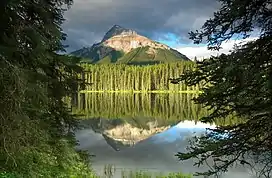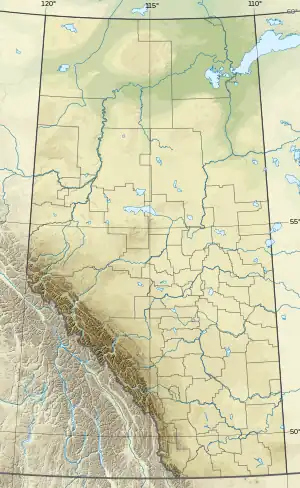| Pilot Mountain | |
|---|---|
 Pilot Mountain from Pilot Pond | |
| Highest point | |
| Elevation | 2,935 m (9,629 ft)[1][2] |
| Prominence | 302 m (991 ft)[3] |
| Parent peak | Mount Brett (2984 m)[3] |
| Listing | Mountains of Alberta |
| Coordinates | 51°11′16″N 115°49′30″W / 51.18778°N 115.82500°W[4] |
| Geography | |
 Pilot Mountain Location in Alberta | |
| Country | Canada |
| Province | Alberta |
| Protected area | Banff National Park |
| Parent range | Massive Range |
| Topo map | NTS 82O4 Banff[4] |
| Climbing | |
| First ascent | 1885 by the GSC[2][3] |
| Easiest route | Difficult scramble[5] |
Pilot Mountain is a mountain in the Bow River valley of Banff National Park in Alberta, Canada. It is located southeast of Redearth Creek and directly west of the Trans-Canada Highway.
The mountain was named in 1884 by George M. Dawson, for its location is where the Bow Valley changes direction, thus affording distant views of the mountain all along the valley.
Pilot Mountain can be scrambled on the northwest face by someone with good routefinding skills. Nearby Mount Brett (2,984 m (9,790 ft)) can be ascended from a ridge off the western slopes of Pilot Mountain.[5]
Geology
Like other mountains in Banff Park, Pilot Mountain is composed of sedimentary rock laid down from the Precambrian to Jurassic periods.[6] Formed in shallow seas, this sedimentary rock was pushed east and over the top of younger rock during the Laramide orogeny.[7]
.jpg.webp)
Climate
Based on the Köppen climate classification, Pilot Mountain is located in a subarctic climate with cold, snowy winters, and mild summers.[8] Temperatures can drop below -20 °C with wind chill factors below -30 °C.
References
- ↑ "Topographic map of Pilot Mountain". opentopomap.org. Retrieved 2022-07-03.
- 1 2 "Pilot Mountain". cdnrockiesdatabases.ca. Retrieved 2019-08-16.
- 1 2 3 "Pilot Mountain". Bivouac.com. Retrieved 2008-11-30.
- 1 2 "Pilot Mountain (". Geographical Names Data Base. Natural Resources Canada. Retrieved 2019-08-16.
- 1 2 Kane, Alan (1999). "Pilot Mountain". Scrambles in the Canadian Rockies. Calgary: Rocky Mountain Books. pp. 206–207. ISBN 0-921102-67-4.
- ↑ Belyea, Helen R. (1960). The Story of the Mountains in Banff National Park (PDF). parkscanadahistory.com (Report). Ottawa: Geological Survey of Canada. Archived (PDF) from the original on 2015-10-02. Retrieved 2019-09-13.
- ↑ Gadd, Ben (2008), Geology of the Rocky Mountains and Columbias
- ↑ Peel, M. C.; Finlayson, B. L. & McMahon, T. A. (2007). "Updated world map of the Köppen−Geiger climate classification". Hydrol. Earth Syst. Sci. 11 (5): 1633–1644. Bibcode:2007HESS...11.1633P. doi:10.5194/hess-11-1633-2007. ISSN 1027-5606. S2CID 9654551.
Further reading
- Shea, Gerry (2010). Mountain Treks in Alberta. Rocky Mountain Books. p. 146. ISBN 9781897522790. Retrieved 2022-07-03.
External links
- Pilot Mountain weather: Mountain Forecast
- Parks Canada web site: Banff National Park
- Pilot Mountain Route Beta - Dow Williams